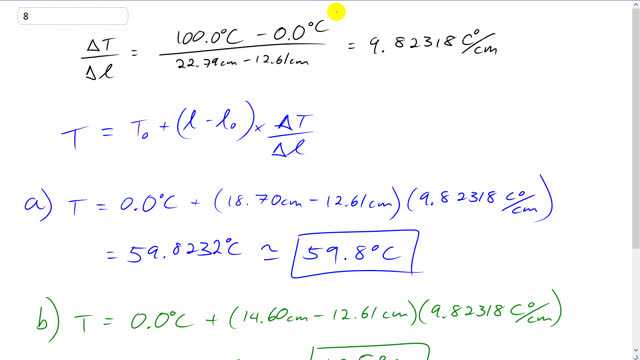
In an alcohol-in-glass thermometer, the alcohol column has length 12.61 cm at and length 22.79 cm at . What is the temperature if the column has length
- 18.70 cm, and
- 14.60 cm?

In order to watch this solution you need to have a subscription.
This is Giancoli Answers with Mr. Dychko. We need to figure out how much the temperature changes per change in number of centimeters length of this alcohol column. So, for a change of 100 degrees Celsius degrees, you get a change of 22.79 centimeters minus 12.61 centimeters. So that makes a change of 9.82318 Celsius degrees per centimeter. And then we can multiply that by that rate of change of temperature with length by the length difference compared to 0. So, if you have 0 degrees Celsius and you have some new length minus the length that it had at 0, and then multiply that by how many Celsius degrees each centimeter represents, will get the new temperature. So, here's a formula for calculating temperature, the reference temperature plus the new length minus the reference length of the alcohol column times the number of Celsius degrees that you get per change in length. So, at 0 degrees Celsius plus 18.7 centimeters minus 12.61 centimeters times 9.82318 Celsius degrees per centimeter. That gives 59.8 degrees Celsius for a column length of 18.7 centimeters. And then when you have 14.6 centimeters the same calculation works out to 19.5 degrees Celsius.
A student wrote: I am confused as to how you derived the equation after finding the ratio. Thank you very much.
There isn't really an explicit equation mentioned in the textbook for this. Notice that the equation resembles an equation for a straight line . This means if you know the "y" intercept (zero in this case), then you can add that to the quantity that varies (the length of the alcohol column in this case) times the amount by which the temperature changes per change in length. That's how I think of it to myself, but that might not make a lot of sense as an explanation... Here's another take:
Consider the first line where we're calculating . I wrote this with numbers, but it could have been written with variables. It would look like this: . Multiply both sides by gives . Then add to both sides, and there you have it: the equation of interest. Hopefully one of those explanations helps.
All the best,
Mr. Dychko